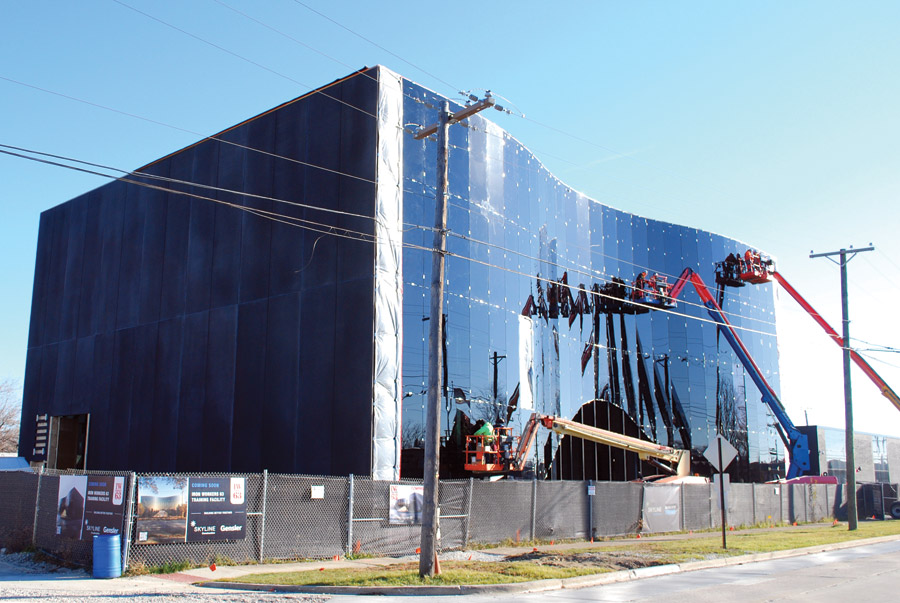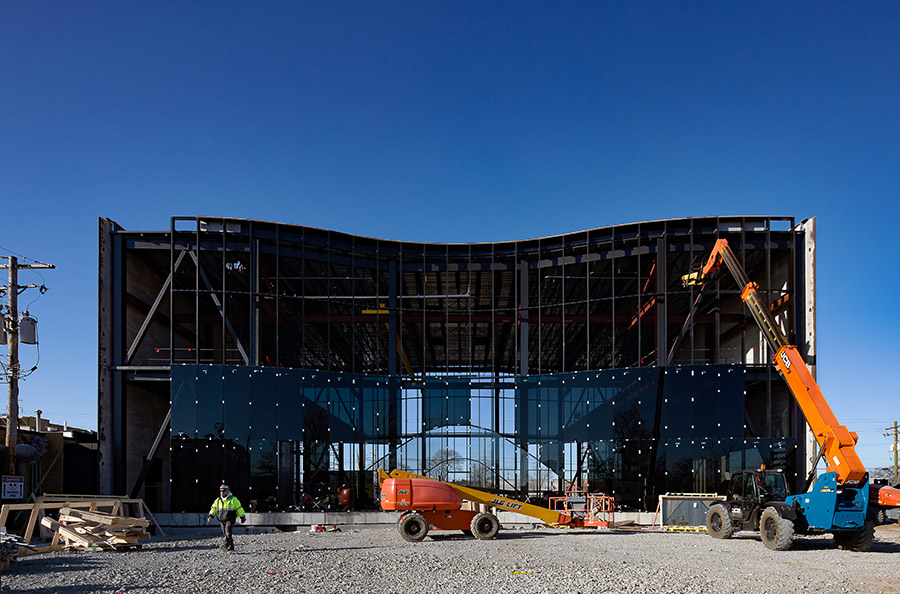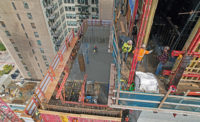Training Facility Designed To Iron Out Labor Shortage
Ironworkers 63 will build test structures with curtain wall inside training facility

Ironworkers 63 made curtain walls a prominent part of their new training facility to display their craft.
Photo courtesy of Skyline Construction
At just 12,000 sq ft, a glass structure is rising in suburban Broadview, outside Chicago, where future occupants will be repeatedly raising up glass curtain walls inside the building.
The training facility for Ironworkers Union 63 will enable apprentices to practice and learn their craft by building test structures. They will learn the complex task of how to install glass curtain walls, which requires skill and precise engineering to ensure structural integrity, weather resistance and energy efficiency.
Ironworkers Local 63 has long had an impact on the Chicago skyline. Their history goes back to the 19th century when the union was founded as the Architectural Iron Workers with 579 members.

The 50-ft-tall building has glass panels with a fritted pattern.
Photo courtesy of Skyline Construction
After the Great Chicago Fire in 1871, which turned three square miles of downtown into rubble and ash, wooden structures were no longer allowed in the downtown area, and the city was rebuilt using steel, which was a relatively new construction material.
Now in the 21st century, the iron workers are hoping that a new training facility will introduce a pipeline of new young workers to the field.
The design for the structure, which is next to the union’s headquarters, was executed by Gensler’s Chicago office. The contractor is Skyline Construction.
For the design and construction team, building the training facility was like putting together the pieces of puzzle, including installing a 5-ton bridge crane and creating exterior walls of flat curtainwall panels that were installed to look curved.
The union is comprised of tradespeople focused on curtain wall installation and decorative and architectural ironwork. In addition to being a high-tech training facility designed to attract a younger workforce to the trade, the building will be a place where the ironworkers can show off their work.

The curtain walls are comprised of flat panels but were installed to look curved.
Photo courtesy of Gensler
Pride in Workmanship
“The ironworkers take a lot of pride in the high-precision craft work that they do,” says Sean McGuire, project architect for Gensler. “They want to show off their craft and have the curtain wall element displayed in their training facility.”
The hour glass-shaped building was originally designed with glass on all four sides, but materials, along with the building height, had to be adjusted due to budget constraints and to allow for the sort of heavy lifting that will be done within the building.
The final design of the 50-ft-tall building has glass curtainwalls with a fritted pattern that highlight the ironworkers’ craft on two sides of the building.
“The ironworkers take a lot of pride in the high-precision craftwork they do. They want to show off their craft and have the curtain wall element displayed in their training facility."
—Sean McGuire, Project Architect, Gensler
“The east and west sides of the building are arc-shaped. They resemble a fillet weld from an aerial view, and they will allow views into the training facility,” McGuire says. “It will be a very active space.”
The north and south sides of the building are structural precast combined with different aggregates in black hues that had to be matched.
Using structural precast shaved dollars off the budget and, because it incorporates more steel, ensures that the structure will be sturdy enough to accommodate the type of training the ironworkers will do.
“The 50-ft-tall panels were prefabricated and dropped by crane on the site,” says Dan Polito, director of operations for Skyline. “We had to have the steel structure up to receive it.”
The interior of the one-story building has mezzanines on the north and south sides overlooking the ground floor where training will occur.
One mezzanine will be used for storage of various types of curtain wall systems; the other will be used for breakout meetings and for ironworkers, apprentices, architects, contractors and others to watch the training taking place on the ground floor.
Slated to open in 2024, the facility will also include a chamber where the curtain walls will be tested against inclement conditions.
“They are going to do water testing,” Polito says. “There will be a large 20-ft-tall chamber where they will mock up curtain wall, essentially having a negative air pressure vacuum on one side of it. They’ll spray down the curtain wall with water and test whether water will come through it.
“Usually you want to keep water outside of a building, but this room challenges that concept,” Polito adds.
He notes that extra floor drains and non-slip flooring were added to handle the water and keep apprentices from slipping.
Curtain wall panels, large pieces of steel and other materials will be received through a roll-up door on the north side that will be opened to provide ventilation as needed.

The building will include a chamber where curtain wall will be tested to make sure it can withstand severe weather conditions.
Photo courtesy of Skyline Construction
Crane Suspended from Ceiling
Glass panels required for training will be placed in the ground floor training area via a 5-ton bridge crane attached to the ceiling.
Planning for installing the bridge crane involved input from various subcontractors, engineers and others. There was little room for mistakes when installing the bridge crane, which took place before the glass was installed.
“There was a small clearance—we’re talking inches,” Polito says. “The bridge crane has to be able to clear over the test structures the apprentices will build. We couldn’t go higher with the roof so it was down to an inch in clearance. It was a puzzle to fit it all in there.”
The bridge crane will also need to maneuver around light fixtures with powerful LEDs that will brighten the interior and provide the necessary illumination for the apprentices’ training.
“There are linear light fixtures right underneath the steel joists in the ceiling so they accentuate the steel inside the building,” McGuire says. “The clearance between the size of the bridge crane and the size of the panels they will pick up [during future training], all of that was finessed during the design process and was challenging.”
“The wall is flat but still reads as curved to the human eye.”
—Patrick Cronin, Project Manager, Skyline Construction
The team looked on with bated breath the day the bridge crane was installed.
“Getting that bridge crane up there was a big win,” Polito says.
The east and west sides of the building are constructed of segmented concrete and the flat glass panels of the curtain wall—both of which needed to mesh to create a curved look of an hourglass to the human eye.
“The glass comes in 4-ft-wide straight sections,” Polito says. “It’s not curved glass. Making sure it looks like a radius glass and making sure there’s no overhang on the either side or on the inside or outside of it was a challenge.”
“The foundation wall is an inch or two bigger than the glass that sits on it. If this foundation wall isn’t exactly where it needs to be and if there’s any deviation between the concrete and the curtain wall, everything isn’t going to line up,” says Patrick Cronin, project manager for Skyline Construction.
“The wall is flat but still reads as curved to the human eye,” Cronin adds.

The 12,000-sq-ft facility will feature a 5-ton bridge crane on the interior to move curtain walls into place for training.
Rendering courtesy of Gensler
Communication is Key
Planning and communication were crucial to the successful placement of the foundation and curtain wall.
“We had to take all our trades, the CAD files and overlays and do extensive layout in the field to understand exactly where this needed to be,” Polito says. “The concrete to the curtain wall had to be within a quarter-inch, and we got within an eighth of an inch. That layout took a lot of collaboration with all the trades to get it to work.”
While training facilities don’t usually draw much attention for their beauty or design approach, this one is planned to become “a jewel box,” according to McGuire, who says it will give the ironworkers a focused space to do cutting-edge work.
For trades looking to attract the next generation of talent, McGuire says creating beautiful, purpose-driven spaces where younger generations will learn can be an important tool in attracting new practitioners, particularly as the construction industry overall struggles with a shortage of skilled workers.
The building, which will glow at night and be visible from the nearby Eisenhower Expressway, will also serve as an advertisement for the type of complex work the ironworkers do, work that has shaped the Chicago skyline over many decades, McGuire says.




